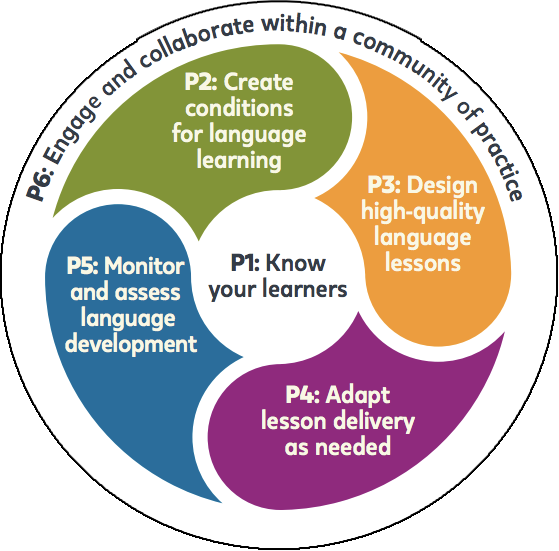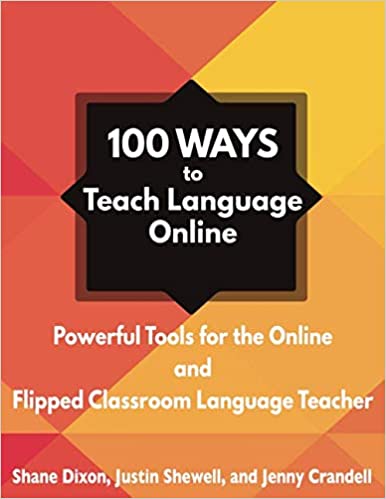
The TESOL International Association (https://www.tesol.org) published a short pamphlet that outlines six principles teachers should follow to be exemplary teachers of English learners (http://www.tesol.org/docs/default-source/books/6P/6p-quickvisualguide_web.pdf?sfvrsn=0). I agree with all of these six principles, and these are what my colleague Dr. Shane Dixon and I teach our students who are planning to become English teachers in our award-winning MOOC, Teach English Now (https://teachenglish.asu.edu). However, as I was looking at these six principles, I realized that one thing was conspicuously missing: technology.
I don't think they left off technology because they think it isn't important. I think left it off because it really applies to all six principles and so it shouldn't be considered a principle by itself. Technology is becoming so important to teaching that exemplary teachers, or all teachers really, MUST use technology if they want to be effective. In this post, I want to talk about how technology can be integrated in connection with each of the six principles. For convenience's sake, I am listing the six principles again here:
- Know your learners
- Create conditions for learning
- Design high-quality lessons
- Adapt delivery as needed
- Monitor and assess language development
- Engage and collaborate within a community of practice
For more detailed descriptions of each principle, see the document published by TESOL at the following link: http://www.tesol.org/docs/default-source/books/6P/6p-quickvisualguide_web.pdf?sfvrsn=0. I should also say that these principles are applicable no matter what subject you teach, and no matter who you teach, so if you are a teacher of any subject, these suggestions can help you improve.
1. Technology Helps You Know Your Learners
For several years now, I have given my students a survey at the beginning of the semester. It is not very long and asks them questions like "What should I call you in class?" and "What are some things you like to do in your free time?". I also ask questions about their language learning goals, such as "What do you want to learn in this class?" and "How do you think you can improve your English this semester?". I have found that students instantly feel they are more than just a warm body sitting at a desk in my classroom and that their teacher cares about them. I use Google Forms to do the survey, which compiles all the results into a spreadsheet for me so I can easily see patterns among the students as well as reference each student's individual responses as needed. I use this information to guide me when setting up groups so I can put students with similar interests together, and calling a student by their preferred name each time I address them is a great way to show your students that you know and care for them.
Using the data from the survey, I'll compile a page of information about each student that contains the survey data and notes about each student's performance and areas of need. I review this information when I am lesson planning to help make sure I am reaching each student as best I can.
Some teachers set up closed social media networks, like Ning (https://www.ning.com), and encourage students to post things about themselves and their lives. This is another great way to get to know your students, not only on a personal level, but on an English-learning level as well. You see students interacting in English and you can see their successes and mistakes in using English to communicate. This is another great way to get to know your students.
2. Technology Helps You Create Conditions for Language Learning
Students learn language best in a variety of ways and environments. Some students are comfortable sitting in a classroom, working in groups, etc. Others are more shy and may not be as verbal in class. Technology can help you provide multiple ways for students to interact in English and multiple opportunities to interact with classroom content. For example, I always post things we've talked about in class on the course website. Students who need more time with the content are able to login to course website and view it when it is convenient for them, and are able to view it at their own pace.
I also use technology to help provide students multiple opportunities and multiple methods to interact in English. For example, I have done conversation assignments where students are asked to go out and record themselves having a conversation in English. Some students just record it once and are done, similar to if I had asked them to do it live in the classroom. However, other students are more shy and might practice with someone and then record several times before they've got it the way they want. Having this flexibility thanks to the integration of technology helps students feel more comfortable. I don't expect any less from the shy students, but they feel more confident in their work and more willing to take risks, which is so important to progression in learning a language.
3. Technology Helps You Design High-Quality Lessons for Language Development
There are really two parts to this principle. First, technology can help you design high-quality lesson plans by giving you access to your institution's objectives or language guidelines, and by helping you know and consider each student's needs as discussed in #1 above. Technology can also provide resources for you to use as you plan your lessons in terms of content. Incorporating videos, images, audio, and other media is a great way to appeal to diverse learners and help students understand lesson content from several angles.
Second, technology can help you design high-quality lesson plans by making it easier for you to help your students develop critical thinking skills and practice authentic language use. Educational technologists often refer to a technology integration model called SAMR, which stands for:
- Substitution
- Augmentation
- Modification
- Redefinition
I like to consider this model when I think about how my students will use technology to accomplish the learning objectives I have given them. For example, if my learning objective was for students to practice problem-solving skills, I might ask them to think about a problem that is local to our school or community, and then to come up with a possible solution to that problem. I might have them write about their solution, and then turn it in to me for a grade. But while that practices some language skills, it is not very much fun and the audience is limited to me as the teacher, which is not very authentic for students. Why should they try hard if I am the only one who is going to read their solution? Instead, I could redefine their learning experience by having them create a digital story about their solution. This typically involves them creating a video where they have to introduce the problem, and then explain their solution and why it is practical. When I say "create a video" I don't mean that they just stand their talking about it. They have to show us the problem and show us the solution. This not only has them practice the problem-solving skills in the way I outlined earlier, but also helps them practice problem-solving skills as they figure out how they will portray the problem and their solution in the video, as they figure out how to record and edit the video, and as they write their script. By incorporating technology, I have given them additional opportunities to achieve the learning objectives in multiple ways. And that is just one example!
4. Technology Helps You Adapt Lesson Delivery as Needed
If you have never used live-polling before in your classroom, you are going to be amazed at the impact it can have on your teaching and student performance. Live-polling refers to the practice of asking students questions and seeing their answers in real-time during a lesson to find out how much they've understand, and then adapting your instruction based on the data you get back. I've used live-polling for many years, even before technology made it so easy. I used to ask my students questions in class, and have them write their answers on small white boards, or even sheets of paper, and hold them up for me to see. I could look around the room and quickly see who had understood and who hadn't, and then adjust my teaching by adding additional explanations or activities based on how much students have understood.
Then I discovered Socrative (https://www.socrative.com). Socrative is a live-polling app that lets you do so much! It has quizzes, so you can give students a quiz and immediately see their results and know how much they've understood. It has "Quick Questions" so I can ask students questions without any pre-planning, and see their results immediately. It even has games students can play using your own questions. I use Socrative in almost every class. For a demonstration of how Socrative works, you can see another blog post I wrote called "How to Use Socrative in the Classroom" (https://jshewell.com/articles/27).
5. Technology Helps You Monitor and Assess Student Language Development
Like the document "Six Principles for Exemplary Teaching of English Learners" says, students learn at different rates and it is often difficult as a teacher to keep each student engaged and on task while taking their varying levels and learning rates into consideration. This is where technology shines. Using technology, you can indvidualize instruction, and provide curriculum that students can access at their own pace. You can have students complete a variety of assessments online and store their results to compare against later on when they take those same assessments again. You can use technology to provide feedback on assessments instantly, or at least in much timelier manner than before. For example, I record my students giving academic presentations in class. Then, I watch the videos as part of my grading process, and I use video-editing software to leave comments on what students did well and what they could improve in their presentations directly on the video. When I'm done, I export the video with my comments and upload it to the course website for the students to view. I require the students to watch their video with themselves presenting and my feedback and then to write a reflection paragraph that includes a goal they want to work on for improvement in their next presentation. Adding my comments into the video allows me to give feedback in a timely manner, and the students can see themselves present and reflect on their performance.
6. Technology Helps You Engage and Collaborate With a Community of Practice
There is no doubt how important continued development is to staying an effective teacher. If you are teaching in a large program, with several English language teachers, engaging and collaborating with a community of practice might not be that difficult. However, if you are the only English language teacher in your school, or even in your region, it becomes much more difficult. You might be able to do somethings to fill the gap, such as attending local and regional TESOL conferences, or even attending the international TESOL Convention. But those conference typically happen once a year, and there is no ongoing development or follow-up afterwards. In one rural area where I was meeting with teachers, we set up a blog for them, and encouraged them to post their ideas on the blog where other teachers could see them. Teachers who visited the blog read their lesson ideas, watched videos of things they had done in their classrooms, and saw examples of student work, and were able to provide feedback and suggestions that greatly enhanced these rural teachers continuing development. They also used Skype to hold meetings with other teachers twice a month where they could discuss issues and problems, and provide suggestions to their fellow teachers. Such collaboration is so important to improving yourself as a teacher and technology now makes it possible for teachers to find each other all over the world.
So, as you think about your teaching methods and style, and how you use technology, make sure you are not just thinking about technology in the classroom. There are so many ways that technology can be integrated to help make you a better teacher!



